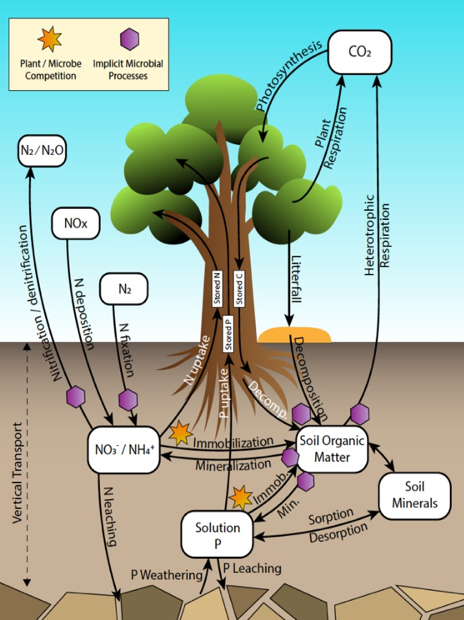v1 Land and Energy
Building from the Community Land Model Version 4.5 (CLM4.5) adopted in E3SM v0, scientists developed the E3SM Land Model (ELM) focusing on enhancing capabilities in a few key areas needed to support the v1 simulation campaigns.
New Approaches to Model Complex Processes

Schematic of coupled carbon-nitrogen-phosphorus dynamics in vegetation and soil as represented in ELM v1. Major new capabilities include introduction of the phosphorus cycle, representation of dynamic storage pools for carbon, nitrogen, and phosphorus within plants, and implicit treatment of microbial biomass and community structure.
To address the v1 BGC science questions regarding the effects of nutrient limitations on carbon-climate feedbacks and their sensitivity to model structural uncertainty, we developed two biogeochemistry approaches in ELMv1 (see figure). In one approach, we integrated in a new theory, Equilibrium Chemical Approximation (ECA), for representing nutrient competition between microbes, plants, and abiotic processes (Tang, 2015; Tang and Riley, 2017; Zhu et al., 2016; Zhu et al., 2017), as well as for leaf-level photosynthesis controls (Ghimire et al., 2016). These processes have been evaluated against site-level observations and implications for global-scale carbon and nitrogen cycle responses have been investigated (Riley et al., 2018; Tang and Riley, 2018; Zhu and Riley, 2015; Zhu et al., 2018). The second approach is the Converging Trophic Cascade (CTC) biogeochemistry framework, which includes phosphorus dynamics (Yang et al., 2016) and plant storage pools as new capabilities. The representation of nutrient limitation and competition among plants and microbes for available nutrients in the CTC framework was investigated in several model-data integration studies, including the use of stable isotope observations (Mao et al., 2016; Raczka et al., 2016; Duarte et al., 2017). A sophisticated and efficient uncertainty quantification capability has been integrated with ELM v1 and is being used to perform global sensitivity analyses (Sargsyan et al. 2014, Safta et al., 2015, Ricciuto et al., 2018) and parameter optimization.
Since many processes controlling ecosystem carbon and nutrient cycling result from vertically-resolved soil processes, a sophisticated multi-phase, multi-species, and multi-transport mechanism reactive transport solver (BeTR) has been implemented in ELMv1 and applied to examine global-scale implications of several nutrient constraint hypotheses (Tang and Riley, 2018). Another new reactive transport capability based on the community model PFLOTRAN has also been integrated (Tang et al., 2016a and 2016b). In preparation for the analysis of results from the v1 coupled biogeochemistry experiments, new detection and attribution methods have been evaluated (Mao et al. 2016).
To support the water cycle experiments, we developed a new soil hydrology model and a new river transport model (MOSART; Li et al., 2013; 2015a) to improve simulations of surface hydrology and river flow, along with their response to anthropogenic forcings. The new soil hydrology solver, the Variably Saturation Flow Model (VSFM), improves on the physics implementation in our predecessor model without degrading computational efficiency (Bisht et al., 2018a).
Besides the above features that have been included in E3SM v1, Phase I activities also included development of model features to enhance capabilities in E3SM v2. Building on the framework of MOSART, we developed a floodplain inundation parameterization (MOSART-inundation) and evaluated it over the Amazon basin (Luo et al., 2017). We also added one-way coupling between MOSART with ELM and a water management model (WM) to simulate the effects of reservoir operations on streamflow (Voisin et al., 2017). Two new modules have also been added to MOSART to represent stream temperature (MOSART-heat) (Li et al., 2015b) and sediment transport (MOSART-sediment). A demographic and dynamic vegetation model, Functionally Assembled Terrestrial Ecosystem Simulator (FATES), has been coupled to ELM and used to assess differences in ecosystem responses to CO2 and climate (Holm et al., 2018), forest recovery from disturbance, and predicted global plant function trait (PFT) distributions without climate envelopes. Lastly, we also explored the implications of human-Earth system interactions using the integrated Earth System Model (iESM; Collins et al., 2015). Thornton et al. (2017) demonstrated the effects of changes in terrestrial productivity on energy, land use, and terrestrial carbon storage in an RCP4.5 scenario using the iESM. A follow-on paper (Calvin et al., in review) exploring these effects in both medium (RCP4.5) and high (RCP8.5) forcing worlds is also in review. Effort is underway to port the iESM code to E3SM, which should be completed by the end of Phase I and ready for testing in v2 as a key feature for the v2 biogeochemistry experiments.
In sum, land model development during Phase I has resulted in new capabilities to model carbon-climate feedbacks that are being used in the v1 biogeochemistry experiments and introduced unique capabilities for modeling the interactions between natural and human systems at regional and global scales that will be prominently featured in the v2 simulation campaign.


